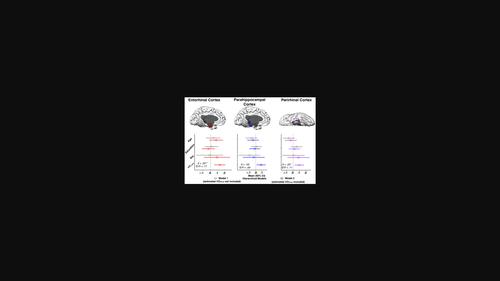当前位置:
X-MOL 学术
›
Eur. J. Neurosci.
›
论文详情
Our official English website, www.x-mol.net, welcomes your feedback! (Note: you will need to create a separate account there.)
Cardiorespiratory fitness is associated with cortical thickness of medial temporal brain areas associated with spatial cognition in young but not older adults
European Journal of Neuroscience ( IF 3.698 ) Pub Date : 2023-12-06 , DOI: 10.1111/ejn.16200 Michael A. Rosario 1, 2, 3 , Kathryn L. Kern 2, 3 , Shiraz Mumtaz 2, 3 , Thomas W. Storer 4 , Karin Schon 1, 2, 3, 5, 6
European Journal of Neuroscience ( IF 3.698 ) Pub Date : 2023-12-06 , DOI: 10.1111/ejn.16200 Michael A. Rosario 1, 2, 3 , Kathryn L. Kern 2, 3 , Shiraz Mumtaz 2, 3 , Thomas W. Storer 4 , Karin Schon 1, 2, 3, 5, 6
Affiliation

|
Cardiorespiratory fitness has a potent effect on neurocognitive health, especially regarding the hippocampal memory system. However, less is known about the impact of cardiorespiratory fitness on medial temporal lobe extrahippocampal neocortical regions. Specifically, it is unclear how cardiorespiratory fitness modulates these brain regions in young adulthood and if these regions are differentially related to cardiorespiratory fitness in young versus older adults. The primary goal of this study was to investigate if cardiorespiratory fitness predicted medial temporal lobe cortical thickness which, with the hippocampus, are critical for spatial learning and memory. Additionally, given the established role of these cortices in spatial navigation, we sought to determine if cardiorespiratory fitness and medial temporal lobe cortical thickness would predict greater subjective sense of direction in both young and older adults. Cross-sectional data from 56 young adults (20–35 years) and 44 older adults (55–85 years) were included. FreeSurfer 6.0 was used to automatically segment participants' 3T T1-weighted images. Using hierarchical multiple regression analyses, we confirmed significant associations between greater cardiorespiratory fitness and greater left entorhinal, left parahippocampal, and left perirhinal cortical thickness in young, but not older, adults. Left parahippocampal cortical thickness interacted with age group to differentially predict subjective sense of direction in young and older adults. Young adults displayed a positive, and older adults a negative, correlation between left parahippocampal cortical thickness and sense of direction. Our findings extend previous work on the association between cardiorespiratory fitness and hippocampal subfield structure in young adults to left medial temporal lobe neocortical regions.
中文翻译:

心肺健康与内侧颞脑区的皮质厚度相关,而内侧颞叶区与年轻人的空间认知相关,但与老年人无关
心肺健康对神经认知健康有显着影响,尤其是海马记忆系统。然而,关于心肺健康对内侧颞叶海马外新皮质区域的影响知之甚少。具体来说,目前尚不清楚心肺健康如何调节年轻成年时的这些大脑区域,以及这些区域与年轻人和老年人的心肺健康是否存在差异相关。这项研究的主要目标是调查心肺健康是否可以预测内侧颞叶皮质厚度,内侧颞叶皮质厚度与海马体一起对空间学习和记忆至关重要。此外,考虑到这些皮质在空间导航中的既定作用,我们试图确定心肺健康和内侧颞叶皮质厚度是否可以预测年轻人和老年人更强的主观方向感。包括 56 名年轻人(20-35 岁)和 44 名老年人(55-85 岁)的横断面数据。FreeSurfer 6.0 用于自动分割参与者的 3T T1 加权图像。通过分层多元回归分析,我们证实了年轻人(而非老年人)较高的心肺健康与较高的左内嗅皮质、左海马旁皮质和左鼻周皮质厚度之间存在显着相关性。左侧海马旁皮质厚度与年龄组相互作用,可差异预测年轻人和老年人的主观方向感。左侧海马旁皮质厚度与方向感之间呈正相关,而老年人则呈负相关。我们的研究结果将之前关于年轻人心肺健康与海马亚区结构之间关联的研究延伸到左内侧颞叶新皮质区域。
更新日期:2023-12-06
中文翻译:

心肺健康与内侧颞脑区的皮质厚度相关,而内侧颞叶区与年轻人的空间认知相关,但与老年人无关
心肺健康对神经认知健康有显着影响,尤其是海马记忆系统。然而,关于心肺健康对内侧颞叶海马外新皮质区域的影响知之甚少。具体来说,目前尚不清楚心肺健康如何调节年轻成年时的这些大脑区域,以及这些区域与年轻人和老年人的心肺健康是否存在差异相关。这项研究的主要目标是调查心肺健康是否可以预测内侧颞叶皮质厚度,内侧颞叶皮质厚度与海马体一起对空间学习和记忆至关重要。此外,考虑到这些皮质在空间导航中的既定作用,我们试图确定心肺健康和内侧颞叶皮质厚度是否可以预测年轻人和老年人更强的主观方向感。包括 56 名年轻人(20-35 岁)和 44 名老年人(55-85 岁)的横断面数据。FreeSurfer 6.0 用于自动分割参与者的 3T T1 加权图像。通过分层多元回归分析,我们证实了年轻人(而非老年人)较高的心肺健康与较高的左内嗅皮质、左海马旁皮质和左鼻周皮质厚度之间存在显着相关性。左侧海马旁皮质厚度与年龄组相互作用,可差异预测年轻人和老年人的主观方向感。左侧海马旁皮质厚度与方向感之间呈正相关,而老年人则呈负相关。我们的研究结果将之前关于年轻人心肺健康与海马亚区结构之间关联的研究延伸到左内侧颞叶新皮质区域。



























 京公网安备 11010802027423号
京公网安备 11010802027423号